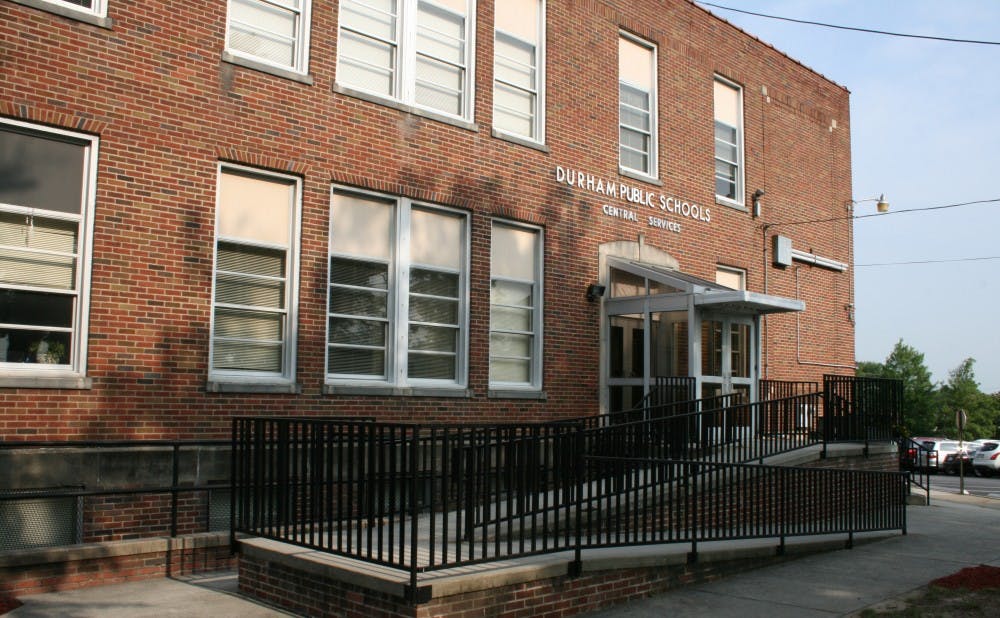Last Thursday, the Durham Public Schools Board voted unanimously to ban representation of the Confederate flag, Ku Klux Klan and Nazi swastika from its dress code.
In addition to banning the racist attire, the seven members of the board decided to strip the name of city philanthropist Julian Shakespeare Carr from the Durham School of the Arts middle school building, citing Carr's historical support of white supremacy. With the ban, students are now prohibited from wearing attire that could be “reasonably expected to intimidate other students on the basis of race” or “any other classification that is protected by law, regulation or Board policy,” according to their published policy. The dress code ban puts Durham up to speed with the Orange County and Chapel Hill-Carrboro school districts, whose boards issued similar bans last month.
“The board was very much aware of the controversy and the tragedy in Charlottesville and thought that it was important to clearly emphasize that symbols of racial intimidation are not appropriate for Durham public schools,” said Chip Sudderth, director of public information for Durham Public Schools.
Both changes follow in the wake of community backlash to the violent white supremacist rally in Charlottesville, Virginia, which spurred national debate on the relevance of historical symbols associated with racism.
In August, Durham protestors toppled a Confederate monument at the front of the old county courthouse, and Duke University President Vincent Price ordered the removal of a statue of Confederate Gen. Robert E. Lee outside the University’s chapel.
This new revision in dress code represents more of a formal change in language rather than practice, Sudderth explained. Local principals had already been monitoring hallways for students dressed in symbols of racial intimidation.
“Principals have always had the authority to ask students to remove or cover articles of clothing or symbols that are disruptive to learning,” he said. “The changes to this policy simply makes it more clear that symbols of racial intimidation are presumed to be disruptive.”
Natalie Beyer, a member of the Durham Board of Education, said the council wanted to formalize its current practices after the events in Charlottesville and leave no room for confusion.
“We went back and thought that it was really important to put this into policy so that everyone is clear—students, teachers, family members—that on school property we don’t have any tolerance for those specific hate symbols,” she said.
Jay Pearson, assistant professor in the Sanford School of Public Policy, said that the board was correct to draw a connection between their banned symbols and the general idea of white supremacy.
White supremacy, he explained, dates back centuries to the exploitation of black Africans as slaves and the appropriation of Native American historical lands through forced relocation. It was during this era that Western European colonizers constructed the idea of a natural hierarchy among human populations.
He noted that symbolic reminders of that historical hierarchy have been used as weapons ever since.
“Symbolic representations that perpetuate ideas of natural hierarchies are problematic because they reinforce or reify these already-existing social perceptions that one group is inherently superior to another,” Pearson said. “Clearly these symbols meet the formal criteria of symbolic representation of terror.”
Beyer explained that the policy’s language was carefully crafted to prohibit broader symbolic representations of hate—not just those based on race. She also noted that the board consulted lawyers while crafting their new policy.
“The case law is complicated,” Beyer said. “But our attorneys are confident that we have written solid policy that affirms First Amendment rights but also makes sure our schools are safe.”
Stuart Benjamin, Douglas B. Maggs Professor of Law and associate dean for research, wrote in an email that although the Supreme Court has already set a precedent for similar school board policies in previous cases, it is unclear how the court would handle the Durham ban in particular.
“Everything rides on how much authority officials at K-12 schools have to police what their students wear at school,” Benjamin wrote. “And on that the Court has been more muddled.”
Sudderth and Beyer said that few locals have objected to the new motion, with the majority of complaints voiced by email.
“Durham is a progressive community, and Durham is an inclusive community,” Sudderth said. “By and large, our community has been generally supportive.”
However, in Pearson's opinion, there is still more to be done. He described one next step as reshaping the school curriculum to dismantle misconceptions about race.
Get The Chronicle straight to your inbox
Sign up for our weekly newsletter. Cancel at any time.
“The critical piece for me is whether we can get our heads around a curriculum that teaches people the historical significance of these symbolic representations, and I think we’re failing at that,” Pearson said. “Let’s actually teach historical accounts in our coursework and in the curriculum, and then folks at the very least will have a sense.”

